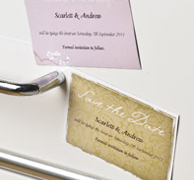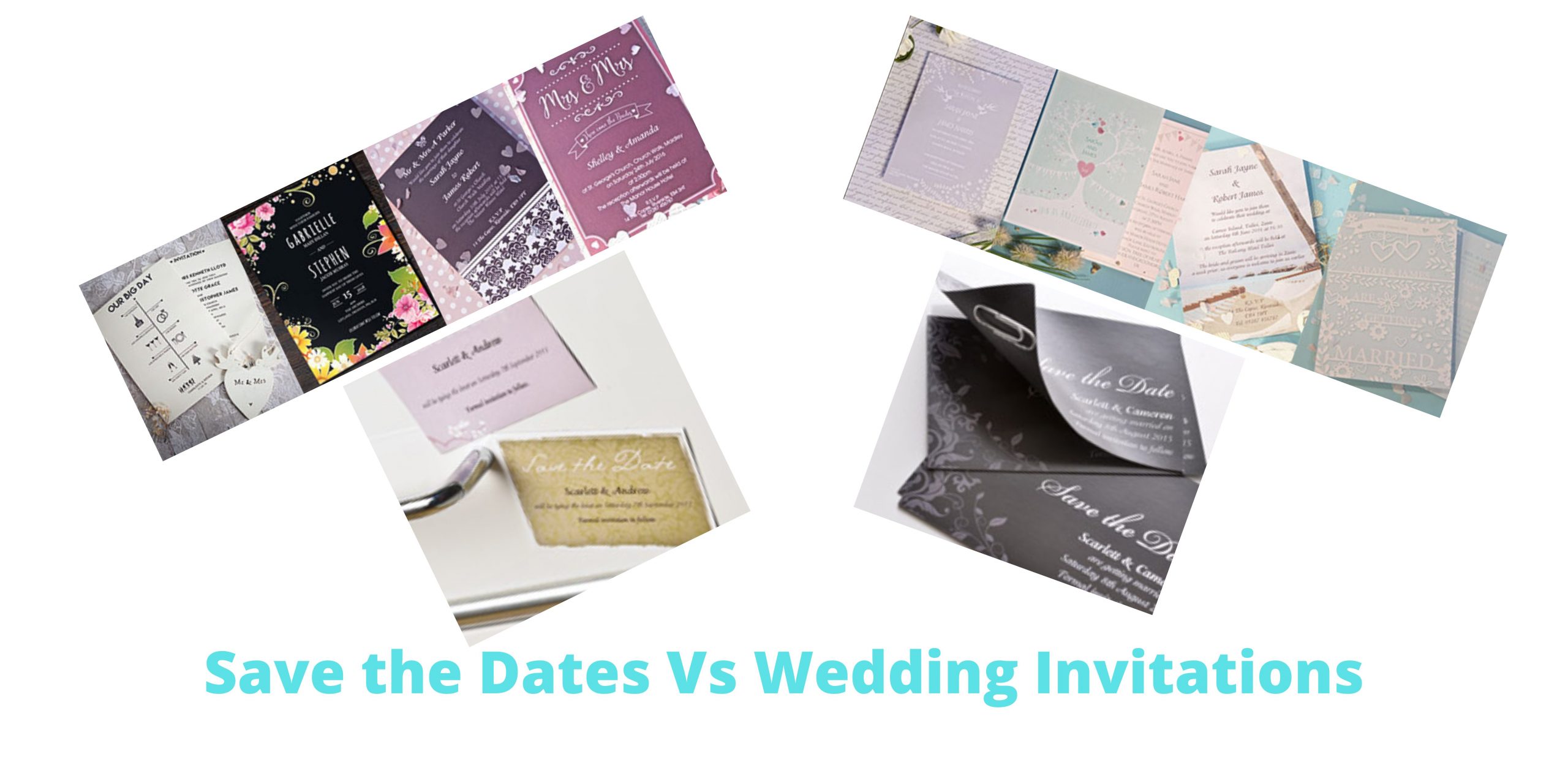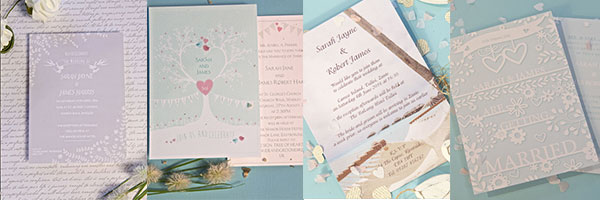You’re keen to make your wedding day as perfect as possible. But now that you’ve begun the process of wedding planning, you’re starting to realise how overwhelming things can get, especially when it comes to all the details that you need to think about.
Having a save the date has become essential when getting married these days. Sent weeks or months before the formal invitation, the save the date will let your invitees know to keep the date free, and to expect an invitation in the future. This vital piece of stationery also gives you the opportunity to set the tone for your wedding, so they can look forward to what’s coming on your big day.
It’s essential to get it done right, because the save the date is the first impression your guests will have of your wedding. In this guide, we’ll talk you through what information needs to go on a save the date, and what you can leave out.
What Information Goes on a Wedding Save the Date?
When creating your wedding save the date, you need to remember one trick: “less is more.”
Since you’re sending out these cards at least six months before your wedding, you don’t need to give out too much information or details about the big day. At this early stage, you probably haven’t even finalised most aspects of your wedding yet anyway. You can save most of the little details for the wedding invitation, which you’ll send later on.
Here’s what you need to put on the save the date:
1) Your wedding date. This is, of course, the most important thing. Your guests will need to know which date to keep free in their calendars.
2) Who’s getting married. Don’t forget to include your names, so that your invitees know whose wedding it is!
3) Your wedding venue. You’ll need to book your venue before you can even think of sending out save the dates. You don’t want to tell everyone to keep March 10th free, only to find out that your venue is already booked up on that day!
Though the date and your names are the most important details, your guests will appreciate knowing the venue in advance. This is particularly true for destination weddings, or weddings held more than 1 hour away from where most of your guests live. This will give them extra time to plan their travel and accommodation.
If you’ve already created a wedding website at this stage, you can also include a link to it on your save the date. However, this isn’t strictly necessary, as long as it’s on the wedding invitation.
“Invitation to Follow”
As your wedding save the date could easily be mistaken for the actual invitation, it’s very important to put a note saying “invitation to follow” somewhere on the card.
This will let the guests know that this isn’t the invitation, and a formal invite will be sent out on a later date.
If you don’t include this detail, your guests may panic that they’ve missed some vital information about your big day – such as what time to arrive at the venue, where the reception will be held or the dress code.
A beautifully designed and professionally printed wedding save the date will get your guests excited for your upcoming nuptials, and give them time to plan their schedule so they can celebrate with you.
What About Destination Save the Dates?
Now, if you’re getting married in a foreign country, you also need to provide your guests with as much travel-related information as possible. This information would generally go on the wedding invitation, but for destination weddings, you want to give your invitees as much notice as you can.
For example:
1) The nearest airport
2) The best airlines and flights
3) What the weather will be like
4) Any vaccinations your guests will need to visit the country in question
5) The names of good hotels near your venue
6) Transit options to and from the airport
This way, you’re saving your guests a lot of time and effort. They can simply book their flights and hotels in advance without going through the hassles of figuring out the best options for their trip.
You should also ensure you send out your save the dates a lot earlier than you would for a domestic wedding (around a year in advance).
What NOT to Include on a Wedding Save the Date
Since your save the date isn’t your final wedding invitation, you can leave out the more intimate details – after all, you may not have even finalised them yet. For example, you don’t need to include:
1) The ceremony start time
2) The reception start time and/or end time
3) Accommodation or transport information
4) A map or directions to the venue
5) The dress code
6) Wedding breakfast menu or food choices
7) Where you’re registered for gifts
If you haven’t finalised the reception venue yet, it’s also okay to leave that information out. Since you’re still in the middle of wedding planning, you don’t need to be pressured into providing all of these details.
As long as you’ve mentioned that an invitation will follow, your guests will know to anticipate this information at a later date.
When Is the Right Time to Send a Wedding Save the Date?
Your save the date will serve as an advance notice for your wedding. So, as a general rule, you should send them out at least six to eight months before the big day, depending on whether your guests will need to travel.
This will give your guests enough time to block off their schedules, plan their budget and book their trip. Bear in mind that your guests may need a little more notice if they live far away.
You should send a wedding save the date to everyone you want at your wedding: family, friends, colleagues. Even if you’ve already told these people about your wedding in person, you still need to give them save the dates as proper courtesy.
Never send a save the date to someone if you’re not 100% sure whether you’re going to invite them or not.
More Top Tips for Writing Save the Dates
Now that we’ve sorted out the basics of a wedding save the date, here are some of the most important things that you need to remember when putting together your card:
1) Don’t include your registry information. Of course, your guests will want to know where you’re registered so they can start thinking about your wedding gift. But that information should be included on your wedding website, not your paper stationery. It’s considered tacky to include this detail on a save the date.
2) How many dates need to be saved? You’re giving out a “save the date” but it’s very important to be specific about the number of days you want the guests to save. For instance, you could say “save the weekend” if you’re planning any activities before or after the big day itself.
3) Forget the RSVP. Although it would be great to get a glimpse of your headcount early on, don’t send out RSVP cards with save the dates. Save these for your proper wedding invitation.
4) Decide on plus ones and kids. When addressing save the dates, you need to be decide how many people you want to invite from that household (including kids), and whether your guests can bring a guest of their own.
For instance, if the guest doesn’t get a plus one, then you only need to print one name on the save the date card. But if you want to invite the entire family, then you can go with “the Smith family” for example. And stay consistent – don’t change your mind between now and the formal invite.
What If You Need to Change the Date?
Now since you’re sending out these save the date cards early on in the wedding planning stage, it’s not out of the realm of possibility that some details about your wedding might change between now and the big day itself. For example, you might need to change your wedding date or venue.
If this happens, you have the option to send a “change the date” card providing the new details. You can use a regular save the date template for this, and simply alter the wording.
You can also post updates on your wedding website, so that guests can easily check in on them whenever they need to recall the details of your wedding.
Where Can I Order Wedding Save the Dates?
Save the date cards are a necessary part of wedding stationery that not only helps your guests plan, but also gets them excited for your upcoming wedding.
Follow these tips to make sure that you get your wedding save the date wording just right. But it’s equally important to choose a beautiful, appropriate save the date card design that will match your wedding theme.
123Print has a wide range of over 200 wedding save the date designs, so you’re bound to find one that matches your wedding aesthetic perfectly. You can choose between small, medium and large cards, or even vinyl magnets!
Ideally, choose a save the date which features the colour your bridesmaids will be dressed in. This hint at your colour scheme allows guests that aren’t in the wedding party to make appropriate attire choices.
When you’ve picked your favourite design, simply open up our editor to input your wedding details at the touch of a button. Your save the dates will be with you within days!





